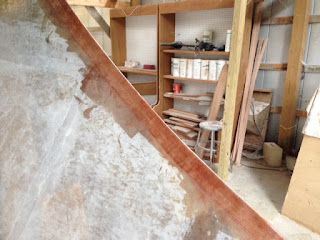The glass on the transom sanded down very nicely especially around the edges where I was most worried.
 |
| I think it looks pretty good. I'm ready to roll on a few more layers of epoxy on this part. |
Now that I am no longer using the large angle grinder, I've rigged a vacuum system for the new belt sander. This was a major increase in my comfort. No more cover-alls, no more dusk mask and no more mess in the shop. I was very pleased with the dust collection. Very little dust is left behind and none gets into the air and on me.
I'm planning a big weekend next week to work on the boat. I'd like to get the hull in shape to roll on the last layers of epoxy. I have a few things planned to that end:
1) Finish rough sanding
update: Made good progress but not finished.
2) Fill dips, crevices and ripples and re-sand
update: Made good progress but not finished.
3) Add three more layers of glass around the bow for extra protection and sand/fill smooth
update: Only added two more layers. I have not filled and smoothed it yet.
4) Wash the hull down for the final coats of epoxy.
update: Nope, not there yet.
My goal is to minimize any sanding after I roll on the final layers of epoxy. I know that there will be a bit of smoothing but I really don't want to have to perform any deep sanding or re-filling. Wish me luck.
Sanding these fill areas was a lot of work and at one point I got the cord stuck in the belt sander. See the Tool Box for more information on that.
I wanted to reinforce the bow and increase the radius of the bow edge to increase dispersal of any impact the bow might encounter. I added two layers of woven cloth tape. One 6 inches (15.3 cm) wide and over that a 10 inch (25 cm) wide strip. I used a small roller to apply epoxy along the bow where I wanted to place the glass. I let it get a little tacky and then rolled on the strips of fiberglass. The sticky surface helped hold the glass around the relatively narrow radius of the bow.
 |
| Two layers of fiberglass 'tape' along the bow for a bit of extra protection and to increase the radius of the bow edge. |

 |
| A straight on view. |
 |
| I like it when my pan released the cured epoxy clean and I can reuse it. |
 |
| A light sand on the glass tape to remove the seam along the edge. |
Okay, so I mentioned in the above image that I had to apply a patch where I sanded through the fiberglass cloth. I have a fairly powerful orbital sander that I had originally bought for auto body work. That was the sander I was using when I sanded through my glass. I tried to use it again this morning to take down an area near the stern that I filled and was surprised at how aggressive it was then I realized that the sanding head was just spinning like a grinder and there was no orbital motion. No wonder I ripped through the glass tape on the bow. I took the sanding head off and removed the bearing that lets the head free rotate and that bearing was frozen solid (Tool Box). I've ordered a new bearing at around $15 and should have it by the end of next week.





